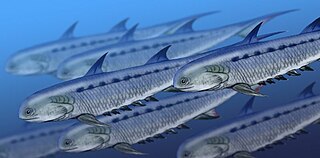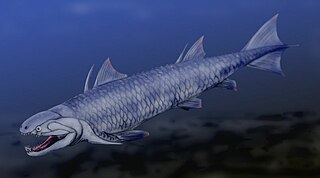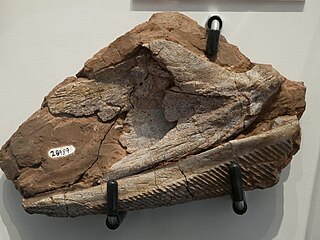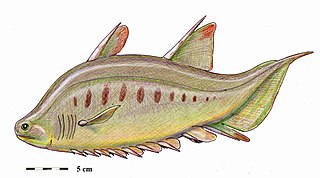
Chondrichthyes is a class of jawed fish that contains the cartilaginous fish or chondrichthyians, which all have skeletons primarily composed of cartilage. They can be contrasted with the Osteichthyes or bony fish, which have skeletons primarily composed of bone tissue. Chondrichthyes are aquatic vertebrates with paired fins, paired nares, placoid scales, conus arteriosus in the heart, and a lack of opecula and swim bladders. Within the infraphylum Gnathostomata, cartilaginous fishes are distinct from all other jawed vertebrates.

Sarcopterygii — sometimes considered synonymous with Crossopterygii — is a clade of bony fish commonly referred to as lobe-finned fish. They are characterised by prominent muscular limb buds (lobes) within their fins, which are supported by articulated appendicular skeletons. This is in contrast to the other clade of bony fish, the Actinopterygii, which have only skin-covered bony spines supporting the fins.

Acanthodii or acanthodians is an extinct class of gnathostomes. They are currently considered to represent a paraphyletic grade of various fish lineages basal to extant Chondrichthyes, which includes living sharks, rays, and chimaeras. Acanthodians possess a mosaic of features shared with both osteichthyans and chondrichthyans. In general body shape, they were similar to modern sharks, but their epidermis was covered with tiny rhomboid platelets like the scales of holosteians.

Stethacanthus is an extinct genus of shark-like holocephalians which lived from the Late Devonian to Late Carboniferous epoch, dying out around 298.9 million years ago. Fossils have been found in Australia, Asia, Europe and North America.

Climatius is an extinct genus of spiny shark. This genus is known from the Early Devonian (Lochkovian) of Europe, previously considered Silurian remains actually belong to Nostolepis instead.

Cheirolepis is an extinct genus of ray-finned fish that lived in the Devonian period of Europe and North America. It is the only genus yet known within the family Cheirolepidae and the order Cheirolepiformes. It was among the most basal of the Devonian actinopterygians and is considered the first to possess the "standard" dermal cranial bones seen in later actinopterygians.

Mesacanthus is an extinct genus of acanthodian fish from Devonian Scotland. It is among the more primitive of the Devonian acanthodians.

Psarolepis is a genus of extinct bony fish which lived around 397 to 418 million years ago. Fossils of Psarolepis have been found mainly in South China and described by paleontologist Xiaobo Yu in 1998. It is not known certainly in which group Psarolepis belongs, but paleontologists agree that it probably is a basal genus and seems to be close to the common ancestor of lobe-finned and ray-finned fishes. In 2001, paleontologist John A. Long compared Psarolepis with onychodontiform fishes and refer to their relationships.

Parexus is an extinct genus of acanthodian fish. Acanthodians are often referred to as ‘spiny sharks’, although acanthodians are not true sharks and evolved perhaps 50 million years earlier than sharks. Acanthodians share several features with bony fish and cartilaginous fish; they often have spines supporting their fins.

Ischnacanthus is an extinct genus of jawed fish in the class Acanthodii. It lived during Pridoli to Lochkovian, type species I. gracilis is only known from Lochkovian.

Sphenacanthus is an extinct genus of a chondrichtyan xenacanthiform that belongs to the Sphenacanthidae family and lived from the Late Devonian, through Carboniferous until the Late Permian period in Scotland, Spain, Russia and Brazil. It lived 359 million years ago, and probably it was one of the first member of the elasmobranchians, the lineage that leads to the modern sharks. Sphenacanthus probably hunts small fishes and, unlike their modern-day relatives, its inhabited fresh water lagoons. Sphenacanthus had seven fins, two in the upper part and five in the underside, and it had a heterodont dentition and mandibles relatively long and deeper. Sphenacanthus serrulatus is still only known from incomplete neurocranial remains and associated dermal material. These suggest that it was a relatively large shark, probably well over one meter in length when fully grown. Its body form was probably similar to that of other phalacanthous sharks.
Guiyu oneiros is one of the earliest articulated bony fish discovered. Fossils of Guiyu have been found in what is now Qujing, Yunnan, China, in late Silurian marine strata, about 425 million years old.

Gyracanthus is an extinct genus of acanthodian.

Brochoadmones is an extinct genus of acanthodian from the Devonian of what is now Canada. It is the only genus in the suborder Brochoadmonoidei, whose relationship to other acanthodian orders remains currently in flux.

Ctenacanthus is an extinct genus of ctenacanthiform chondrichthyan. Remains have been found in the Bloyd Formation of Arkansas and the Cleveland Shale of Ohio in the United States and in South America.

Gyracanthides is an extinct genus of acanthodian gnathostome, known from Devonian to Early Carboniferous.

Ptomacanthus is an extinct genus of spiny shark, an early relative of living cartilaginous fishes.

Acanthodiformes is an order of acanthodian fishes which lived from the Early Devonian to Early Permian.

Lebachacanthus is a genus of extinct xenacanth known from the late Carboniferous-Early Permian of Europe. During the late Paleozoic, xenacanths were the apex predators of freshwater ecosystems, preying on small amphibians.



















